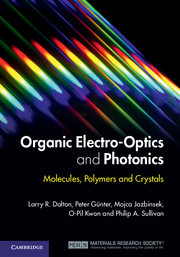Description
Organic Electro-Optics and Photonics
Molecules, Polymers, and Crystals
Authors: Dalton Larry R., Günter Peter, Jazbinsek Mojca, Kwon O-Pil, Sullivan Philip A.
Definitive guide to modern organic electro-optic and photonic technologies, from basic theoretical concepts to practical applications in devices and systems.
Language: English
Subject for Organic Electro-Optics and Photonics:
Approximative price 90.79 €
In Print (Delivery period: 14 days).
Add to cart
Publication date: 07-2015
300 p. · 18.2x25.3 cm · Hardback
300 p. · 18.2x25.3 cm · Hardback
Description
/li>Contents
/li>Biography
/li>
This definitive guide to modern organic electro-optic and photonic technologies provides critical insight into recent advances in organic electro-optic materials, from the underlying quantum and statistical concepts through to the practical application of materials in modern devices and systems. ? Introduces theoretical and experimental methods for improving organic electro-optic and photonic technologies ? Reviews the central concepts of nonlinear optics, focusing on multi-scale theoretical methods ? Provides clear insight into the structure and function relationships critical to optimizing the performance of devices based on organic electro-optic materials. Serving as a primer for the systematic nano-engineering of soft matter materials, this is an invaluable resource for those involved in the development of modern telecommunication, computing, and sensing technologies depending on electro-optic technology. It is also an indispensable work of reference for academic researchers and graduate students in the fields of chemistry, physics, electrical engineering, materials science and engineering, and chemical engineering.
1. Introduction; 2. Nonlinear optical effects; 3. Electro-optic effects; 4. Molecular nonliner optics; 5. Acentric self-assembled films; 6. Crystalline materials; 7. Electrically poled organic materials and thermo-optic materials; 8. Overview of applications; 9. Organic electro-optic waveguides, switches, and modulators; 10. Nonliner optical infrared and terahertz frequency conversion; 11. Photorefractive effect and materials; 12. Conclusions and future prospects.
Larry R. Dalton is the Founding Director of the National Science Foundation Science and Technology Center on Materials and Devices for Information Technology Research, Director of the DARPA MORPH program, and Director of two Department of Defense MURI Centers. He received the American Chemical Society Award in the Chemistry of Materials, and the IEEE/LEOS William Streifer Scientific Achievement Award. He is a Fellow of the American Chemical Society, the Materials Research Society, the Optical Society of America, the SPIE, and the American Association for the Advancement of Science.
Peter Günter is Emeritus Professor at the Swiss Federal Institute of Technology (ETH) and a member of the board of Rainbow Photonics Ltd in Zürich. His main research interests include electro-optics and integrated optics, nonlinear optics, ferroelectric and polar organic materials as well as THz photonics. He has written and edited ten books on photorefractive phenomena, laser-induced dynamic gratings and organic nonlinear optics, and is a fellow of the Optical Society of America.
Mojca Jazbinsek is a member of the ETH spin-out, Rainbow Photonics AG. At Rainbow Photonics she is currently working on applied research projects on organic nonlinear optical materials for high-speed electro-optics and THz-wave generation. Her research interests include novel organic electro-optically active materials with enhanced stability and their integration into photonic circuits, and novel infrared photosensitive materials for light processing, phase conjugation, spatial and spectral beam manipulation.
O-Pil Kwon is associate professor at the Department of Molecular Science and Technology and the Department of Applied Chemistry and Biological Engineering at the Ajou University in South Korea. His research interests include organic functional materials and supramolecular ordered materials for electro-optic, terahertz wave and electronic applications.
Philip A. Sullivan is Assistant Research Pr
Peter Günter is Emeritus Professor at the Swiss Federal Institute of Technology (ETH) and a member of the board of Rainbow Photonics Ltd in Zürich. His main research interests include electro-optics and integrated optics, nonlinear optics, ferroelectric and polar organic materials as well as THz photonics. He has written and edited ten books on photorefractive phenomena, laser-induced dynamic gratings and organic nonlinear optics, and is a fellow of the Optical Society of America.
Mojca Jazbinsek is a member of the ETH spin-out, Rainbow Photonics AG. At Rainbow Photonics she is currently working on applied research projects on organic nonlinear optical materials for high-speed electro-optics and THz-wave generation. Her research interests include novel organic electro-optically active materials with enhanced stability and their integration into photonic circuits, and novel infrared photosensitive materials for light processing, phase conjugation, spatial and spectral beam manipulation.
O-Pil Kwon is associate professor at the Department of Molecular Science and Technology and the Department of Applied Chemistry and Biological Engineering at the Ajou University in South Korea. His research interests include organic functional materials and supramolecular ordered materials for electro-optic, terahertz wave and electronic applications.
Philip A. Sullivan is Assistant Research Pr
© 2024 LAVOISIER S.A.S.



